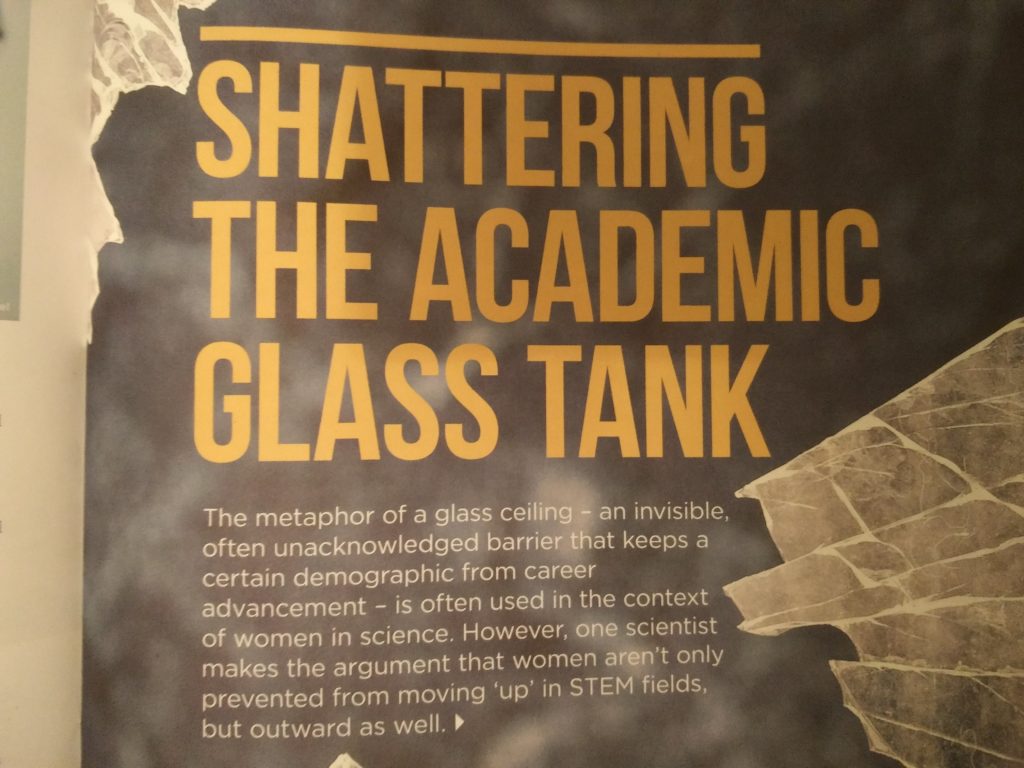My article for the EAIE Forum – Our Gendered World |
The metaphor of a glass ceiling, an invisible, often unacknowledged barrier that keeps a certain demographic from career advancement, is often used in the context of women in science. The phenomenon is so globally widespread that it has given rise to the concept of a “Glass Ceiling Index”, an indicator used to quantify gender equity in science. The GCI is one of many measures employed by the European Commission in the SHE Figures document, outlining the current state of gender equality in research and innovation throughout the European Union.
The presence of women is, unsurprisingly, the lowest in STEM (science, technology, engineering and mathematics) fields, as these disciplines have traditionally attracted more male than female scholars on all academic levels. However, even in STEM subjects with a high intake of female undergraduates, such as biological sciences, there is a disproportionate lack of female progression onto next stages of academic career, despite high academic achievements of women at all levels. Thus, while the number of women is high at an undergraduate stage, the proportion decreases at each progression point – postgraduate, postdoctoral, lecturer – leaving very few females at the professorial level. This progressive drop-out is known as “the leaking pipeline”, and is both global and trans-disciplinary.
Beyond undergrad
Currently in many countries females comprise around 50% of undergraduate students; in Europe, the representation of women at this stage is often higher than of men – e.g. in Sweden it reaches 65%. Yet, according to the SHE Figures report, at the professorial level the proportion of women is very low, for the most part below 15%. Once again, the figures are most drastic in the STEM subjects, as while European humanities and social sciences find themselves with 30% and 23.5% of female full-time professors, these numbers stand at only 9.8% in engineering and technology, and 15.8% in the natural sciences.
What is more, there is a pronounced gender pay gap in academia. According to statistics from the UK collated by the University and College Union, in 2015-16, women on academic contracts earned, on average, 12% less than their male counterparts. In the US and Canada that figure was just under 14% for full professors (based on data from the U.S. Education Department and Canadian Association for University Teachers).
Many explanations have been put forward to account for the glass ceiling phenomenon and the resultant major underrepresentation of qualified women in leadership roles – institutional biases, implicit and direct discrimination (including outright sexism), exclusion from the Old Boys’ Club, lack of role models, difficult work-life choices, or lack of confidence in the women themselves. The contributing factors are so numerous and diverse, that two researchers, Kris De Welde and Sandra L. Laursen, suggested an alternative name for the difficulties women face in academia: the “glass obstacle course”.
The glass fence
Meanwhile, another “glass” problem arises – the “glass fences” keeping women out of collaborative, international projects. International collaborations are a fundamental part of research, particularly in STEM fields. Multi-national projects bring together varied expertise, background, facilities and perspectives. Publications co-authored by international teams have a substantially higher impact than domestic-only papers: they get a wider readership, are cited more often, and have more influence on the scientific community, policy makers and other stakeholders. In order to maximise their scientific output and impact, today’s researchers attempt to be as mobile as possible, often internationally. However, while in other areas, such as business, international mobility carries with it bonuses such as paying school fees for the children, or assisting with finding a job for the spouse, academia still assumes that the researcher is single, unattached, with no caring responsibilities. According to Katherine Zippel, associate professor of sociology at Northeastern University, women are triply disadvantaged when it comes to international mobility – they tend to have less access to international opportunities as they are less likely to obtain positions at better funded institutions; they are in non-tenured, less secure job positions then men, which hampers the creation of a stable international network, and finally, they are the ones who most often bear the brunt of family-related responsibilities.
As a result, women are less likely to participate in international collaborations (23.5% compared to 33% of men, in a study of doctoral recipients in academic positions in America). What is more, they are less likely to co-author publications with international colleagues, despite the overall growing trend in cross-national collaborations (as stated by Elsevier’s Gender in the Global Research Landscape report). In STEM fields, this contributes to the ongoing underrepresentation of women.
Breaking the glass
One way of addressing gender inequality in British institutions is the Athena SWAN (Scientific Women’s Academic Network) charter, founded in 2005. It recognises and celebrates examples of good practice towards the advancement of gender equality in higher education and research. Some of the recognised actions include outreach and mentoring programmes, reducing bias in recruitment, devising flexible and part-time working schemes which ensure career progression, or providing better access to childcare. Initially, the programme was limited to STEM subjects; currently it has expanded to include other disciplines.
Similarly, mobility schemes such as the Marie Sklodowska-Curie Fellowship allow women to actively pursue an international career in science. Currently in dual-career households it is often the higher-earning partner who dictates the mobility strategy – therefore providing financial independence and promoting equal pay leads female scientists towards a much more international professional life.
Research by Mary Bonawitz and Nicole Andel shows that in 2009 the average age of American college professors was 59, and their gender male. Most of these professors will be retiring by the age of 70, creating a gap that may be filled by a new wave of an equally accomplished, if more diverse, professorial body. Creating a working environment which takes into account the needs of parents, carers, researchers with special needs, will be beneficial for the new academic generation.
